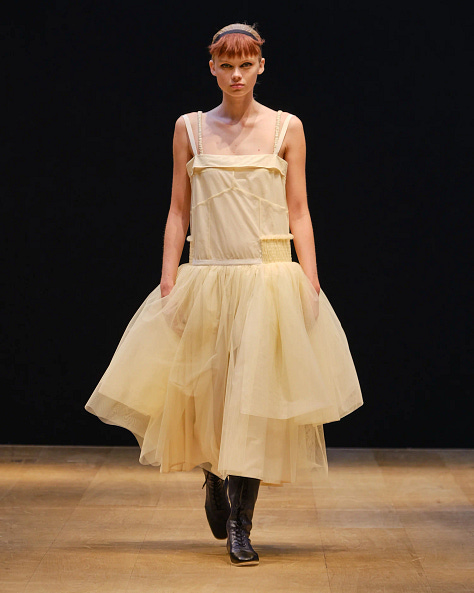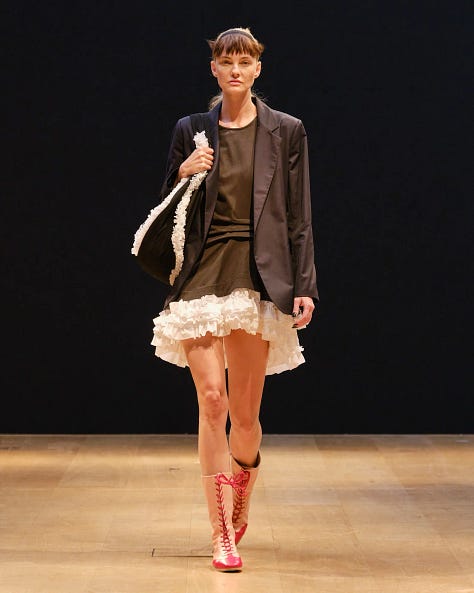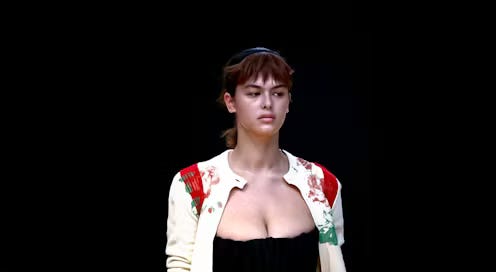The impending chaos of fashion month is almost upon us. As many freelancers– hi :) – brace themselves for one of the most intense feast or famine cycles of the fashion calendar, there are darker-than-usual rumblings in the fashion world's inner circles of what lies in store for this September.
Shockingly no, I am not talking about the proliferation of boring white dude creative directors who are all copying one another, no, instead we are talking about the economics of fashion.
Brands have been navigating post-COVID economic instability for multiple seasons now, but this year felt even more precarious with the shuttering of several online wholesalers– Matchesfashion being a main proprietor of this– and as a result, the fashion calendar is missing some fan favourite brands for SS25 shows. Most notably absent (read: heartbreaking for me) is Molly Goddard foregoing a runway presentation for her SS25 collection in London. As much as not seeing Goddard’s name on the London schedule was an immense letdown, it's not entirely surprising. Many smaller independent (read: interesting) brands like Goddard’s rely on mega e-retailers like Matches, FarFetch, YOOX Net-A-Porter, SSENSE, etc. to do the bulk of the heavy lifting for their sales however, these wholesalers are still chasing their tails after COVID.



Initially during COVID sales in any non-essential industry were down significantly as people clutched their pearls, literally and figuratively, to wade out the economic uncertainty of a global pandemic. Once people started to adjust to the “new normal” (sorry for using that phrase, I think we can collectively agree that it has become as maniacally triggering as trying to fall asleep with a fly buzzing around your ear) and people started to receive unemployment cheques, luxury spending increased to new highs. As someone who spent an entire CERB cheque on a Driade Roly Poly chair and a Simone Rocha runway top from a Totokaelo liquidation sale while severely concussed from a mountain biking accident, I wistfully yearn for these days– for the record, I would have spent my money that way regardless of brain health.
With an increased demand from consumers for luxury items came an increase in wholesale orders from stores to brands, ‘cause capitalism. This increase in demand led to a frenzy in the corporate fashion world of trying to fulfil orders during a pandemic, and with no end in sight, wholesalers placed increasingly large orders with brands under the guise that this spending was the new normal. Thanks to modern medicine the pandemic slowed and things have returned to normal, but the economy is now majorly faltering which means less spending on luxury. This has now led wholesalers to sit on unsellable product from seasons past.
As Beverly Hills Siren for the ages, Erika Jayne has been known to croon:
There’s only one way down so here we go, here we go
Goin’ down like dominos, dominos
Dum, didi, dum, it’s all we know
Of course the supply and demand caught up to everyone and wholesalers like Matches and FarFetch owe millions of dollars to brands due to unsold inventory. Initially, this may not seem that catastrophic to the fashion world’s indie darlings, but if wholesalers aren’t selling inventory that means brands aren’t seeing a dime for the items they have paid to have produced for these seemingly behemoth retailers. It’s sad because this impacts everyone in the ecosystem, all the way down to the grossly underpaid factory workers who make the garments and up to the corporate fashion baddies (also grossly underpaid, but relatively less so).
So, where does this leave us? How is this relevant to Molly Goddard and the tulle tutu-shaped hole that will inevitably be left in my heart post-London Fashion Week? As wholesalers shutter without being able to pay invoices from brands, designers are left without tens to hundreds of thousands of dollars– unless you’re Toteme then it’s £1M from Matches alone– of expected income for product they paid to produce, and are making cuts elsewhere to make up for lost revenue. The cost of orchestrating a runway show can be ruinous, and although they are a great marketing tool and speak to the validity of a luxury brand, they are one of the more sensible extras to cut. Although many brands halted shipments once they realized what was happening, many designers had already shipped the bulk of their SS24 collections to Matches before the collapse was palpable which is how so many lost so much revenue.
The way for brands to recover from this is to up their ready-to-wear and DTC sales, however, the dominance of wholesale websites makes this easier said than done. Wholesaler websites have begun to act as online equivalents to what a department store was in the 20th century in turn, brands have become conditioned over the past decade to see these wholesalers as the main artery to move product through.
Unfortunately, the collapse of these larger companies impacts independent designers the most and it feels especially stark when there is a lack of innovation by bigger brands right now. It’s frustrating because these larger, more established, heritage brands are the ones with the money and security to take risks. Instead, independent labels are the ones taking the risks and making interesting pieces, yet these independent brands don’t generate much income and are often reliant on arts funding to stay afloat which is continuously being cut by governments around the world. If one more Sebato de Sarno-looking creative director gets appointed to a mega brand and continues to make lacklustre silhouettes— and DEMANDING full look policy for styling!!!!!!!!— I will kms. (still enraged Simone Rocha was passed up to takeover McQueen). Anyway, I swear I love fashion and trust Chopova Lowena and Simone Rocha have got us this LNDFW. See you on da fashion streets!




